
The Daytona 500 is a 500-mile-long (805 km) NASCAR Cup Series motor race held annually at Daytona International Speedway in Daytona Beach, Florida. It is the first of two Cup races held every year at Daytona, the second being the Coke Zero Sugar 400, and one of three held in Florida, with the annual fall showdown Straight Talk Wireless 400 being held at Homestead south of Miami. From 1988 to 2019, it was one of the four restrictor plate races on the Cup schedule. The inaugural Daytona 500 was held in 1959 coinciding with the opening of the speedway and since 1982, it has been the season-opening race of the Cup series.
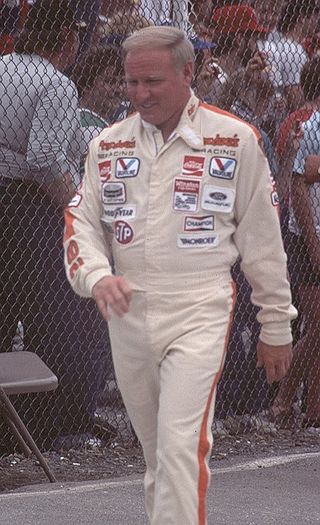
William Caleb "Cale" Yarborough was an American NASCAR Winston Cup Series driver and owner, businessman, farmer, and rancher. He was the first driver in NASCAR history to win three consecutive championships, winning in 1976, 1977, and 1978. He was one of the preeminent stock car drivers from the 1960s to the 1980s and also competed in IndyCar events. His fame was such that a special model of the Mercury Cyclone Spoiler II was named after him.

The Quaker State 400 available at Walmart is a NASCAR Cup Series stock car race that was run annually each March at Atlanta Motor Speedway in Hampton, Georgia from 1960 to 2010 and as a July race since 2021. The race is one of two races currently held at the Atlanta track every season, with the Ambetter Health 400 being the other and run at various times.
The 1976 NASCAR Grand National Winston Cup Series was the 28th season of professional stock car racing in the United States, the 5th modern era season of the Grand National series and sixth under R. J. Reynolds sponsorship through its Winston cigarette brand. The season began on Sunday, January 18 and ended on Sunday, November 21. Cale Yarborough, driving the #11 Junior Johnson Holly Farms Chevrolet scored his first of three consecutive NASCAR Grand National Series Winston Cup Championships. Skip Manning was named NASCAR Rookie of the Year.

The 1979 Daytona 500, the 21st annual running of the event, was the second race of the 1979 NASCAR Winston Cup Series season. It was held on February 18, 1979 at Daytona International Speedway, in Daytona Beach, Florida. It has been called the most important race in stock car history.
The 1977 NASCAR Grand National Winston Cup Series was the 29th season of professional stock car racing in the United States and the 6th modern era NASCAR Cup series. The season began on Sunday, January 16 and ended on Sunday, November 20. Cale Yarborough driving the Junior Johnson #11 Holly Farms Chevrolet won his second consecutive NASCAR Grand National Series Winston Cup Championship. Ricky Rudd was crowned NASCAR Rookie of the Year.

The 1978 Daytona 500, the 20th running of the event, was the second race of the 1978 NASCAR Winston Cup season. It was held on February 19 at Daytona International Speedway in Daytona Beach, Florida. Defending winner Cale Yarborough won the pole and Bobby Allison won the race.

The 1984 Daytona 500, the 26th running of the event, was held February 19, 1984, at Daytona International Speedway in Daytona Beach, Florida. Cale Yarborough, who won the pole, completed a lap of 201.848 miles per hour (324.843 km/h), officially breaking the 200 miles per hour (320 km/h) barrier at Daytona. He won the race for the second year in a row, and the fourth time in his career, with an identical last-lap pass as the previous year, this time passing Darrell Waltrip who would later go on to win the same race in 1989.
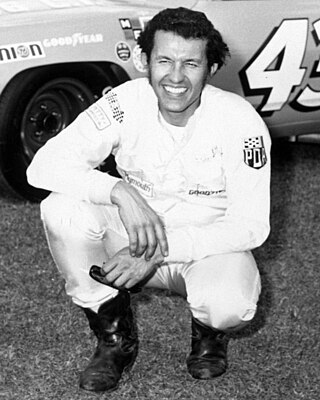
The 1979 NASCAR Winston Cup Series was the 31st season of professional stock car racing in the United States and the 8th modern-era Cup series. It began on Sunday, January 14, and ended on Sunday, November 18. Richard Petty won his seventh and final Winston Cup championship, winning by 11 points over Darrell Waltrip. Dale Earnhardt was crowned NASCAR Rookie of the Year.

The 1977 Daytona 500, the 19th running of the event, was held on February 20, 1977, as the second race of the 1977 NASCAR Winston Cup Series Season.

The 1971 Daytona 500, the 13th running of the event, was a NASCAR Winston Cup Series race held on February 14, 1971 at Daytona International Speedway in Daytona Beach, Florida. Spanning 500 miles (800 km) on the paved oval track, it was the first Daytona 500 in the Winston Cup era of NASCAR. During this time, Richard Petty was becoming one of the winningest veterans on the NASCAR circuit.
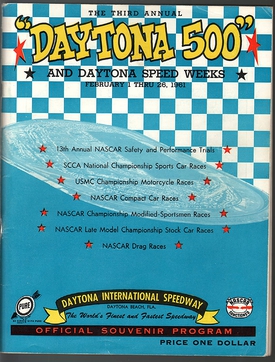
The 1961 Daytona 500, was a NASCAR Grand National Series event that was held on February 26, 1961, at Daytona International Speedway in Daytona Beach, Florida.
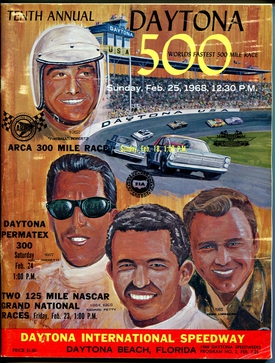
The 1968 Daytona 500 was a NASCAR Grand National Series race held on February 25, 1968, at Daytona International Speedway in Daytona Beach, Florida. Cale Yarborough won the race from the pole
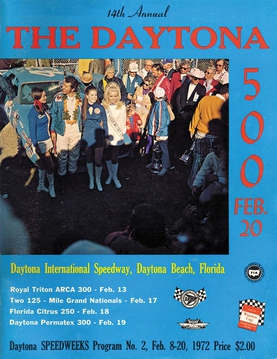
The 1972 Daytona 500, the 14th running of the event, was held on February 20, 1972, at Daytona International Speedway in Daytona Beach, Florida. A. J. Foyt, driving a 1971 Mercury, won the race.

The 1966 NASCAR Grand National Series evolved into the first of three NASCAR Grand National championships for David Pearson, whose 15 wins through the season was second only to Tim Flock's 18 victories in 1955 at that time. NASCAR allowed the return of the Chrysler Hemi engine in 1966, and at the same time Ford decided to boycott NASCAR for the season. The season marked series first visit to the state of Maine. Pearson captured the championship with 35,638 points over second place James Hylton who finished the season with no wins, but 33,638 points for his consistency and efforts.
The 1973 NASCAR Winston Cup Series was the 25th season of professional stock car racing in the United States and the 2nd modern-era Cup season. The season began on Sunday January 21 and ended on Sunday October 21. 31 races were scheduled in the 1973 season. 28 were held.

The 1975 NASCAR Grand National Winston Cup Series was the 27th season of professional stock car racing in the United States and the 4th season in the modern era of the NASCAR Cup series. The season began on Sunday, January 19 and ended on Sunday, November 12. Richard Petty, driving the #43 Petty Enterprises STP Dodge scored his sixth NASCAR Grand National Series Winston Cup Championship. Bruce Hill was named NASCAR Rookie of the Year. NASCAR introduced a new points system for 1975, a system designed by statistician Bob Latford. For the first time, each race on the NASCAR Winston Cup Grand National schedule carried an equal point value, a system that would be used for 36 seasons, from 1975 to 2010, with modifications in 2004 and 2007 each time by increasing the emphasis for a win in adding five additional points each time for a race winner. The original points system ran for the first 29 seasons, from 1975 to 2003.
This article documents historical records, statistics, and race recaps of the Daytona 500, held annually at Daytona International Speedway in Daytona Beach, Florida.

The 1969 Dixie 500 was a NASCAR Grand National Series event that was held on August 10, 1969, at Atlanta International Raceway in Hampton, Georgia.















